Contents
- GDP growth slows to 4.2%, Q4 slumps to 3.1%
- Fiscal deficit widens to 4.6% of GDP in FY20
- Amarnath Yatra to be held only for 15 days in 2020
- U.K. moots ‘5G club’ to keep out Huawei
- Law Minister rakes up SC verdict quashing NJAC
- 4.5-magnitude earthquake felt in NCR
GDP GROWTH SLOWS TO 4.2%, Q4 SLUMPS TO 3.1%
Focus: GS-III Indian Economy
Why in news?
- Economic growth slowed to an 11-year low of 4.2% in 2019-20, according to data released by the National Statistical Office on 29th May 2020.
- In the final quarter of the year, that is, January-March, the growth rate of Gross Domestic Product (GDP) fell to 3.1%.
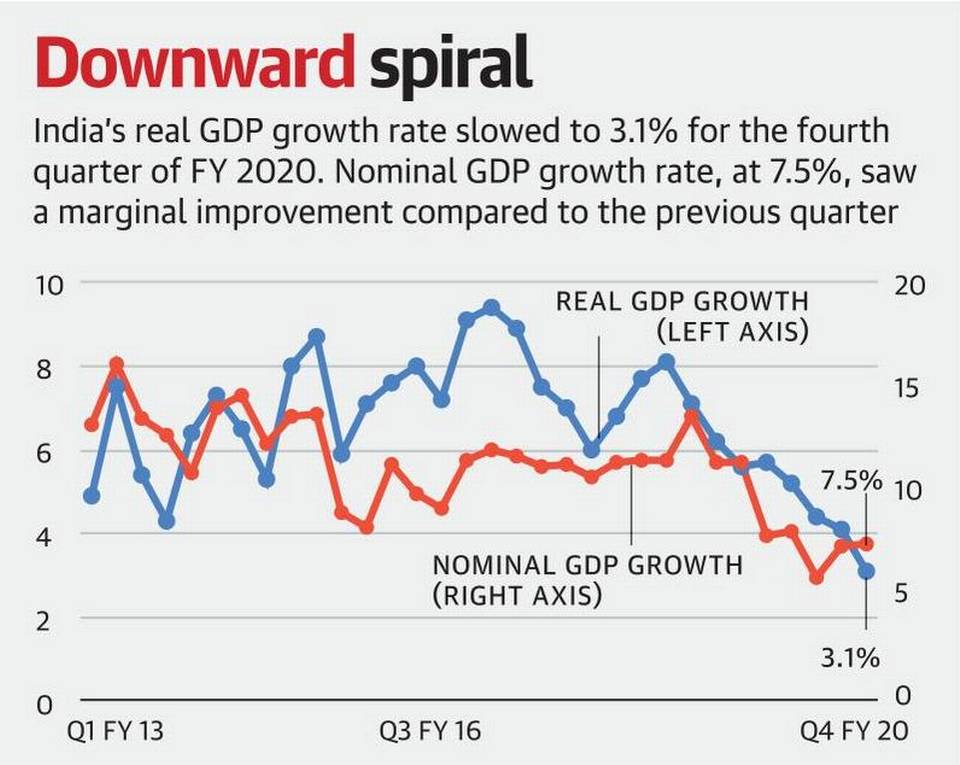
Key Points to Note
- It is the Lowest Growth rate in the past 44 years.
- Agriculture and mining sectors picked up steam in the fourth quarter, growing at rates of 5.9% and 5.2% respectively.
- The manufacturing sector contracted further, recording a negative growth of 1.4%.
- Public administration, defence and other services grew at 10.1%.
- The NSO also revised and pegged its provisional growth estimate for the whole 2019-20 year at 4.2%. to Compare – The Indian economy grew at 6.1% in 2018-19.
- Controller General of Accounts data shows that the Centre’s gross tax revenues fell an unprecedented 3.4% in 2019-20.
- Fiscal deficit increased to 4.6% of GDP, well above the revised estimate of 3.8%.
What do the Numbers mean?
- The three components of demand have fallen, consumption demand has slowed, while investments and exports are both in negative territory.
- In the five years before the 2008 crisis, we had maintained an 8% GDP grwoth, so the capacity to endure and recover was stronger.
- Now we are faced with a weaker economy and much weaker public finances and fiscal capacity.
-Source: The Hindu
FISCAL DEFICIT WIDENS TO 4.6% OF GDP IN FY20
Focus: GS-III Indian Economy, Prelims
Why in news?
The country’s fiscal deficit widened to 4.6 per cent of the Gross Domestic Product in 2019-20 mainly on account of poor revenue realization.
Details
- The deficit, which signifies the gap between government revenue and expenditure, is higher than the revised estimate of 3.8 per cent for the fiscal.
- According to the Controller General of Accounts (CGA) data, the fiscal deficit for 2019-20 worked out to be 4.59 per cent of the GDP, while the revenue deficit was 3.27 per cent.
- The increase in the fiscal deficit has been mainly on account of shortfall in revenue collection during 2019-20.
- The revenue receipts during the year worked out to be only 90 per cent of the revised estimate.
- In absolute terms, total receipts of the government were Rs 17.5 trillion against the estimate of Rs 19.31 trillion.
- The data showed the government’s total expenditure was Rs 26.86 trillion, lower than Rs 26.98 trillion projected earlier.
What is fiscal deficit?
It is the difference between the Revenue Receipts plus Non-debt Capital Receipts (NDCR) and the total expenditure.
In other words, fiscal deficit is “reflective of the total borrowing requirements of Government”.
What is the significance of fiscal deficit?
- In the economy, there is a limited pool of investible savings. These savings are used by financial institutions like banks to lend to private businesses (both big and small) and the governments (Centre and state).
- If the fiscal deficit ratio is too high, it implies that there is a lesser amount of money left in the market for private entrepreneurs and businesses to borrow.
- Lesser amount of this money, in turn, leads to higher rates of interest charged on such lending.
- So, simply put, a higher fiscal deficit means higher borrowing by the government, which, in turn, mean higher interest rates in the economy.
- A high fiscal deficit and higher interest rates would also mean that the efforts of the Reserve Bank of India to reduce interest rates are undone.
-Source: Business Standard
AMARNATH YATRA TO BE HELD ONLY FOR 15 DAYS IN 2020
Focus: GS-I Art and Culture, Prelims
Why in news?
The annual Amarnath Yatra, which was earlier curtailed because of the coronavirus pandemic, will be held only for 15 days this year – a decision that was taken during a meeting held by Jammu and Kashmir lieutenant governor on 28th May 2020.
Last year, the Amarnath Yatra was cut short following intelligence inputs of terror threats ahead of the Centre scrapping Article 370 in Jammu and Kashmir and in 2018, the pilgrimage was held for 60 days.
Amarnath Temple
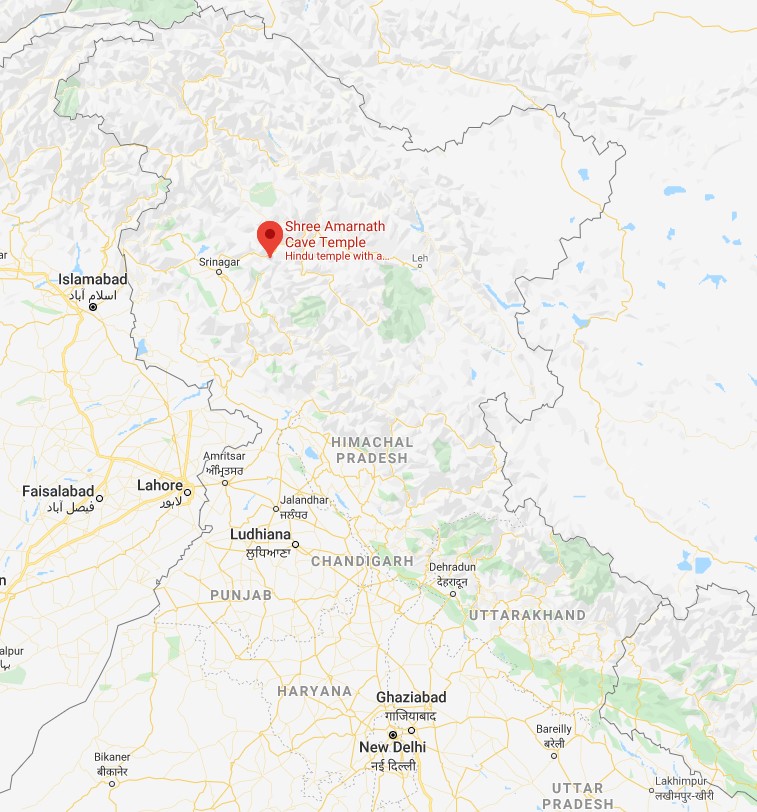
- Amarnath cave is a Hindu shrine located in Jammu and Kashmir, India. The cave is situated at an altitude of 3,888 m (12,756 ft) at about 141 km (88 mi) from Srinagar.
- The Amarnath temple is one of the 51 Shakti Peethas, temples throughout South Asia that commemorate the location of fallen body parts of the Hindu deity Sati (Sati is the first consort of Shiva, the second being Parvati who is the reincarnation of Sati.).
- Inside the 40 m (130 ft) high Amarnath cave, a stalagmite is formed due to freezing of water drops that fall from the roof of the cave on to the floor and grows up vertically from the cave floor – It is considered to be a Shiva Linga by Hindus.
- The shrine forms an important part of Hinduism, and is considered to be one of the holiest shrines in Hinduism.
- Hundreds of thousands of Hindu devotees make an annual pilgrimage to the Amarnath cave across challenging mountainous terrain.
Amarnath Yatra
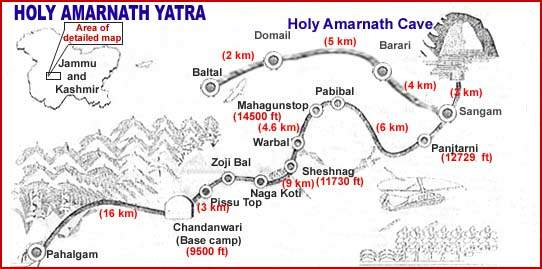
- Amarnath Yatra is a pilgrimage visit to Amarnath cave which is a Hindu shrine located in Jammu and Kashmir, India.
- The peak pilgrimage occurs when the iced stalagmite Shiv lingam reaches the apex of its waxing phase through the summer months.
- Pilgrims visit the holy site during the 45-day season around the festival of Shravani Mela in July–August, coinciding with the Hindu holy month of Shraavana.
- Devotees have to travel on their foot while completing the yatra.
Stalagmite and Stalactite
- A stalactite is an icicle-shaped formation that hangs from the ceiling of a cave and is produced by precipitation of minerals from water dripping through the cave ceiling. Most stalactites have pointed tips.
- A stalagmite is an upward-growing mound of mineral deposits that have precipitated from water dripping onto the floor of a cave. Most stalagmites have rounded or flattened tips.
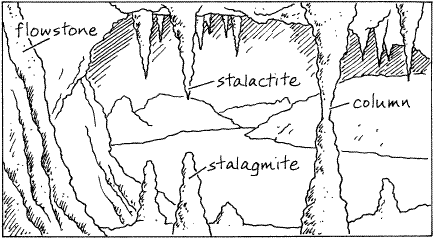
-Source: Hindustan Times
U.K. MOOTS ‘5G CLUB’ TO KEEP OUT HUAWEI
Focus: GS-III Science and Technology, Prelims
Why in news?
Britain said on 29th May 2020 that it was pushing the U.S. to form a club of 10 nations that could develop its own 5G technology and reduce dependence on Huawei.
The prospect of creating a 5G Club of 10 democracies includes India.
This announcement comes amid growing security concerns related to Chinese telecom giant Huawei.
5G Club
Proposed D10 club of democratic partners includes G7 countries – UK, US, Italy, Germany, France, Japan and Canada – plus Australia, South Korea and India.
- It will aim to create alternative suppliers of 5G equipment and other technologies to avoid relying on China.
- It can be seen as a means to ensure that these new entrants belong to like-minded democratic regimes, thus alleviating any security concerns.
- This move will also allow more 5G equipment and technology providers to come up.
- It basically addresses the raised concerns regarding potential surveillance and breach of their national security by China using the state-run Huawei.
5G and India’s Potential
- India’s is the second biggest smartphone market in the world, leading to an exponential rise of data consumption – India consumes more than 11 GB/user/month — the highest in the world.
- There is no practical way in which fiber net connectivity can be enhanced quickly in India which poses a serious challenge to back-haul capacities of the macro towers.
- The Fourth Industrial Revolution (aka Industry 4.0) is powered by emerging technologies like artificial intelligence, machine learning, Internet of Things, Edge Computing, which need 5G to be effective. This will also raise additional revenue streams for the network carriers which are already stressed with financial burdens.
- It will also help with India’s Smart Cities Mission as 5G powers the technology driving smart cities.
What is 5G?
5G is the 5th generation mobile network. It is a new global wireless standard after 1G, 2G, 3G, and 4G networks.

5G wireless technology is meant to deliver:
- Higher multi-Gbps peak data speeds,
- Ultra-low latency,
- More reliability,
- Massive network capacity,
- Increased availability, and
- More uniform user experience to more users.
5G is based on OFDM (Orthogonal frequency-division multiplexing), a method of modulating a digital signal across several different channels to reduce interference.
5G uses 5G NR air interface alongside OFDM principles. 5G also uses wider bandwidth technologies such as sub-6 GHz and mm Wave.
Way Forward for India
- One of the primary concerns in the regard of network is the prevailing financial crisis of telecom industry.
- The spectrum policy should focus on incentivizing heavy investment in 5G, including support for long-term, exclusive, technology-neutral spectrum Licences.
- The Government and operators can collaborate to create an ecosystem capable of leveraging 5G technology with a favorable policy that will indirectly enable advances in areas including employment, technology and investment.
- The shift from 4G to 5G is not incremental in nature, but transformational with the entire world looking to upgrade to 5G, hence, skipping it is not a choice that we can afford.
-Source: Them Hindu
LAW MINISTER RAKES UP SC VERDICT QUASHING NJAC
Focus: GS-III Governance, Indian Polity, Prelims
Why in news?
Expressing ‘serious reservation’ on the 2015 Supreme Court ruling that had quashed the National Judicial Appointments Commission (NJAC) in favour of the present Collegium system, Law Minister raised concerns as to why the government and the Prime Minister cannot be trusted “to appoint a fair and objective judge.”
National Judicial Appointments Commission (NJAC)
- National Judicial Appointments Commission (NJAC) was a proposed body which would have been responsible for the appointment and transfer of judges to the higher judiciary in India.
- The Commission was established by amending the Constitution of India through the ninety-ninth constitution amendment with the Constitution (Ninety-Ninth Amendment) Act, 2014.
- A new article, Article 124A, (which provides for the composition of the NJAC) has been inserted into the Constitution.
- Hence, NJAC is a Constitutional Body.
- The NJAC would have replaced the collegium system for the appointment of judges as invoked by the Supreme court via judicial fiat by a new system.
- Along with the Constitution Amendment Act, the National Judicial Appointments Commission Act, 2014, was also passed by the Parliament of India to regulate the functions of the National Judicial Appointments Commission.
Composition of NJAC
As per the amended provisions of the constitution, the Commission would have consisted of the following six persons:
- Chief Justice of India (Chairperson, ex officio)
- Two other senior judges of the Supreme Court next to the Chief Justice of India – ex officio
- The Union Minister of Law and Justice, ex-officio
- Two eminent persons
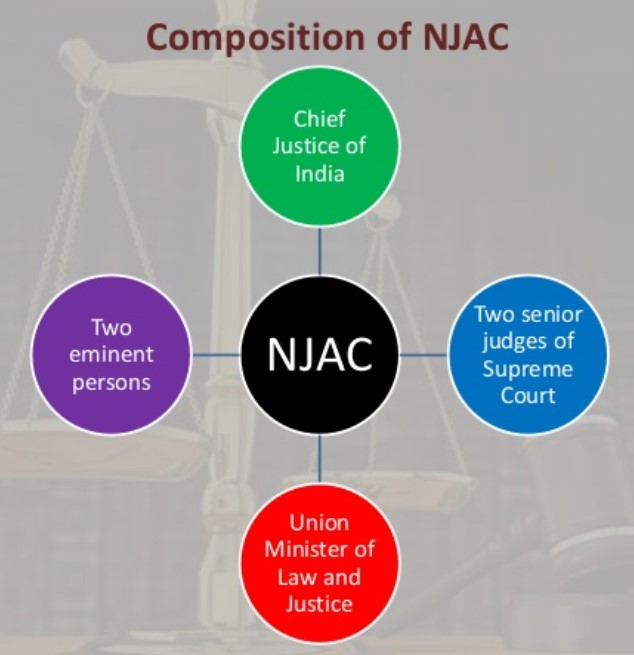
These (two) eminent persons would have been nominated by a committee consisting of the: Chief Justice of India, Prime Minister of India, and Leader of Opposition in the Lok Sabha (or where there is no such Leader of Opposition, then, the Leader of single largest Opposition Party in Lok Sabha), provided that of the two eminent persons, one person would be from the Scheduled Castes or Scheduled Tribes or OBC or minority communities or a woman.
The eminent persons shall be nominated for a period of three years and shall not be eligible for re-nomination.
-Source: The Hindu
4.5-MAGNITUDE EARTHQUAKE FELT IN NCR
Focus: GS-I Geography, Prelims
Why in news?
A magnitude 4.5 earthquake hit Haryana’s Rohtak, over 65 km from Delhi, on 29th May with its epicentre at a depth of 5 km, the National Centre for Seismology (NCS) said.
This is the latest in a series of temblors that have hit Delhi and the adjoining areas since April.
What is an Earthquake?
An Earthquake is a tectonic movement caused by endogenetic (originating within the earth) thermal conditions inside earth’s interior which is transmitted through the surface layer of the earth.
Focus and epicentre of an earthquake
Focus
The point within the earth s crust where an earthquake originates is called the focus. It is also referred as seismic focus or hypocenter. It generally lies within the depth of 60 kilometers in the earth crust.
Epicentre
The point vertically above the focus on the earth s surface is known as epicenter. Earthquake travel in the form of the longitudinal wave from the focus to epicentre. The intensity is the highest at the epicentre. That is why the maximum destruction occurs at and around the epicentre. The intensity of vibrations decreases as one moves away from the epicentre.
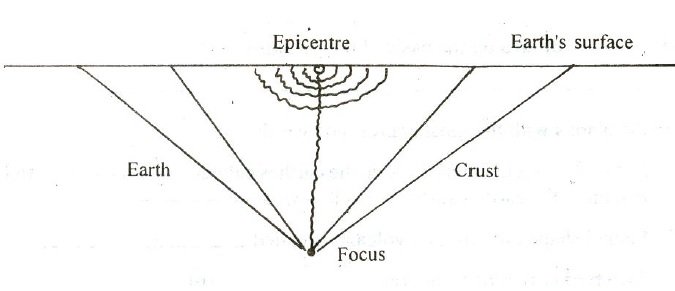
Earthquakes in India
- Himalayan belt– Collision between Indo-Austral plate with Eurasian plate and Burma Plate with Java Sumatra plate. This collision causes lots of strain in underlying rocks’ energy of which is released in the form of earthquakes.
- Andaman and Nicobar Islands– Seafloor displacement and underwater volcanoes which disturb the equilibrium of earth’s surface
- Deccan Plateau– some earth scientists have come up with a theory of the emergence of a fault line and energy build-up along the fault line of the river Bhima (Krishna) near Latur and Osmanabad (Maharashtra).
- Increasing population and unscientific land use in construction make India a high-risk land for earthquakes.
-Source: Hindustan Times





